Superregnum: Eukaryota
Cladus: Unikonta
Cladus: Opisthokonta
Cladus: Holozoa
Regnum: Animalia
Subregnum: Eumetazoa
Cladus: Bilateria
Cladus: Nephrozoa
Superphylum: Deuterostomia
Phylum: Chordata
Subphylum: Vertebrata
Infraphylum: Gnathostomata
Megaclassis: Osteichthyes
Cladus: Sarcopterygii
Cladus: Rhipidistia
Cladus: Tetrapodomorpha
Cladus: Eotetrapodiformes
Cladus: Elpistostegalia
Superclassis: Tetrapoda
Cladus: Reptiliomorpha
Cladus: Amniota
Cladus: Synapsida
Cladus: Eupelycosauria
Cladus: Sphenacodontia
Cladus: Sphenacodontoidea
Cladus: Therapsida
Cladus: Theriodontia
Subordo: Cynodontia
Infraordo: Eucynodontia
Cladus: Probainognathia
Cladus: Prozostrodontia
Cladus: Mammaliaformes
Classis: Mammalia
Subclassis: Trechnotheria
Infraclassis: Zatheria
Supercohors: Theria
Cohors: Eutheria
Infraclassis: Placentalia
Cladus: Boreoeutheria
Superordo: Laurasiatheria
Cladus: Ferae
Ordo: Carnivora
Subordo: Feliformia
Familia: Herpestidae
Genus: Herpestes
Species: H. brachyurus – H. edwardsii – H. fuscus – H. ichneumon – H. javanicus – H. naso – H. palustris – H. semitorquatus – H. smithii – H. urva – H. vitticollis
Name
Herpestes Illiger, 1811: 135
Synonyms
Calogale Gray, 1865
Calictis Gray, 1865
Herpertes Illiger, 1811
Ichneumon Frisch, 1775
Mangusta Horsfield, 1822
Mesobema Hodgson, 1841
Onychogale Gray, 1865
Taeniogale Gray, 1865
Urva Hodgson, 1837
Xenogale Allen, 1919
Vernacular names
беларуская: Мангусты
日本語: エジプトマングース属
References
Primary references
Illiger, J.K.W. 1811. Prodromus systematis mammalium et avium additis terminis zoographicis utriusque classis, eorumque versione germanica. C. Salfield: Berolini. xviii + 302 pp. BHL Reference page.
Links
Herpestes in Mammal Species of the World.
Wilson, Don E. & Reeder, DeeAnn M. (Editors) 2005. Mammal Species of the World – A Taxonomic and Geographic Reference. Third edition. ISBN 0-8018-8221-4.
Herpestes is a genus within the mongoose family Herpestidae. Several species in the family are known as slender mongooses. It is the type genus of the family, and comprises 5-6 living species, each with several subspecies. Fossil remains of three prehistoric species were excavated in France, and described in 1853.
Characteristics
The living Herpestes species are sexually dimorphic, with females smaller than males. They range in weight from 0.6 to 3.6 kg (1.3 to 7.9 lb).[2] They share several characteristics, including the shape of the cheek teeth and of the tympanic bullae, and the presence of the first upper molar teeth. They are all solitary.[3] Males have one chromosome less than females, as one Y chromosome is translocated to an autosome.[4]
Classification
The scientific name Herpestes was proposed by Johann Karl Wilhelm Illiger in 1811 for mongoose species in the south of the Old World, commonly called "Ichneumon" at the time.[5] Until 1835, 12 mongoose species from Africa and Asia were classified as belonging to the genus Herpestes.[6] In 1864, John Edward Gray listed 22 Herpestes species, which he considered as part of the Viverridae.[7] In 1882, Oldfield Thomas reviewed African mongoose zoological specimens in natural history museums. He subordinated those into the genus Herpestes that have nearly naked soles, four premolars, small last lower molars with two external cusps and whose last upper molars are 40-60% smaller than the last upper premolars. His list comprised eight species in Africa.[8] St. George Jackson Mivart listed 21 Herpestes species, including seven in Africa and 13 in Asia. He also determined Herpestes species by the dentition of mongoose specimens. His criteria included small premolars, small inner cusps of the third upper premolars and transversely extended second upper molars with rather concave posterior margins; their bodies are long with long tails, short legs and five digits to each paw.[9] Wallace Christopher Wozencraft recognised 10 Herpestes species as valid in 2005.[1]
The extinct Herpestes lemanensis was excavated in tertiary depositions in the Loire Valley in central France and described in 1853.[10] It most likely dates to the Late Oligocene.[11]
Phylogenetic analysis of African and Asian mongoose specimens revealed that they belong to three distinct genetic lineages; the two African lineages diverged in the Early Miocene around 19.1 million years ago and 18.5 million years ago, and the Asian Urva lineage at around 17.4 million years ago. The following African mongooses are now placed in the genus Herpestes:[12]
| Image | Name | Distribution and IUCN Red List status |
|---|---|---|
 |
Egyptian mongoose (H. ichneumon) (Linnaeus, 1758)[13] | LC[14]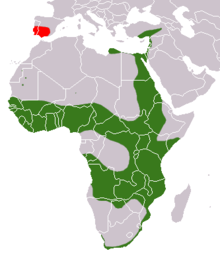 |
 |
Common slender mongoose (H. sanguineus) Rüppell, 1835[6] | LC[15]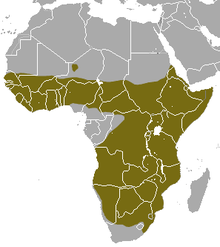 |
.jpg/220px-Cape_Gray_Mongoose_on_Lion's_Head_(29813836777).jpg) |
Cape gray mongoose (H. pulverulentus) (Wagner, 1839)[16] | LC[17]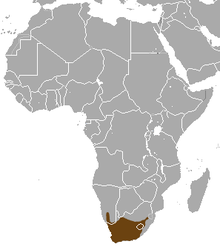 |
 |
Somalian slender mongoose (H. ochraceus) Gray, 1848[18] | LC[19]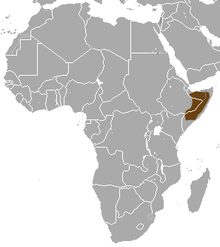 |
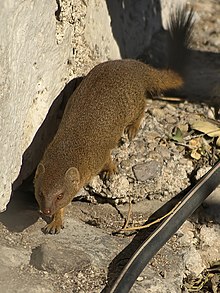 |
Angolan slender mongoose (H. flavescens) (Bocage, 1889)[20] | LC[21] |
References
Wozencraft, W. C. (2005). "Genus Herpestes". In Wilson, D. E.; Reeder, D. M. (eds.). Mammal Species of the World: A Taxonomic and Geographic Reference (3rd ed.). Johns Hopkins University Press. p. 567–570. ISBN 978-0-8018-8221-0. OCLC 62265494.
Taylor, M.E. & Matheson, J. (1999). "A craniometric comparison of the African and Asian mongooses in the genus Herpestes (Carnivora: Herpestidae)". Mammalia. 63 (4): 449–464. doi:10.1515/mamm.1999.63.4.449. S2CID 84384697.
Veron, G.; Colyn, M.; Dunham, A. E.; Taylor, P. & Gaubert, P. (2004). "Molecular systematics and origin of sociality in mongooses (Herpestidae, Carnivora)" (PDF). Molecular Phylogenetics and Evolution. 30 (3): 582–598. doi:10.1016/S1055-7903(03)00229-X. PMID 15012940.
Fredga, K. (1977). "Chromosomal Changes in Vertebrate Evolution". Proceedings of the Royal Society of London. Series B, Biological Sciences. 199 (1136): 377–397. doi:10.1098/rspb.1977.0148. JSTOR 77302. PMID 22865. S2CID 32364326.
Illiger, C. (1815). "Überblick der Säugethiere nach ihrer Verteilung über die Welttheile" [Overview of mammals according to their distribution across the World]. Abhandlungen der physikalischen Klasse der Königlich-Preußischen Akademie der Wissenschaften. 1804−1811: 39−159.
Rüppell, E. (1835). "Herpestes. Illiger". Neue Wirbelthiere zu der Fauna von Abyssinien gehörig [New vertebrates belonging to the Fauna of Abyssinia] (in German). Frankfurt am Main: S. Schmerber. pp. 27–32.
Gray, J.E. (1864). "A revision of the genera and species of Viverrine animals (Viverridae) founded on the collection in the British Museum". Proceedings of the Zoological Society of London (November): 502–579.
Thomas, O. (1882). "On the African Mungooses". Proceedings of the Zoological Society of London (January): 59–93.
Mivart, St. G. J. (1882). "On the Classification and Distribution of the Aeluroidea". Proceedings of the Zoological Society of London (February): 135–270.
Pomel, A. (1853). "Herpestes. Illig.". Catalogue méthodique et descriptif des vertébrés fossiles découverts dans le bassin hydrographique de la Loire. Paris: Baillière. pp. 64–66.
Lydekker, R. (1887). "Herpestes lemanensis, Pomel". Catalogue of the fossil Mammalia in the British museum, (Natural History). Vol. 5, Supplement. London: British Museum (Natural History). p. 317.
Patou, M.; Mclenachan, P.A.; Morley, C.G.; Couloux, A.; Jennings, A.P.; Veron, G. (2009). "Molecular phylogeny of the Herpestidae (Mammalia, Carnivora) with a special emphasis on the Asian Herpestes". Molecular Phylogenetics and Evolution. 53 (1): 69–80. doi:10.1016/j.ympev.2009.05.038. PMID 19520178.
Linnaeus, C. (1758). "Viverra ichneumon". Caroli Linnæi Systema naturæ per regna tria naturæ, secundum classes, ordines, genera, species, cum characteribus, differentiis, synonymis, locis (in Latin). Vol. Tomus I (decima, reformata ed.). Holmiae: Laurentius Salvius. p. 41.
Do Linh San, E.; Maddock, A.H.; Gaubert, P. & Palomares, F. (2016). "Herpestes ichneumon". IUCN Red List of Threatened Species. 2016: e.T41613A45207211.
Do Linh San, E. & Maddock, A.H. (2016). "Herpestes sanguineus". IUCN Red List of Threatened Species. 2016: e.T41606A45206143.
Wagner, J.A. (1839). "Über die Verwandtschafts-Verhältnisse der Pharaonsratte". Gelehrte Anzeigen der Königlich Bayerischen Akademie der Wissenschaften zu München. 9 (183): 425–429.
Do Linh San, E. & Cavallini, P. (2015). "Herpestes pulverulentus". IUCN Red List of Threatened Species. 2015: e.T41600A45205999.
Gray, J.E. (1848). "Description of a new species of Herpestes, from Abyssinia". Proceedings of the Zoological Society of London (November): 138–139.
Taylor, M.E. & Do Linh San, E. (2015). "Herpestes ochraceus". IUCN Red List of Threatened Species. 2015: e.T41605A86159385.
Bocage, J.V.B. (1889). "Mammifère d'Angola et du Congo". Jornal de Sciencias mathematicas, physicas e naturaes. 2. 1: 174–185.
Rapson, S. & Rathbun, G.B. (2015). "Herpestes flavescens". IUCN Red List of Threatened Species. 2015: e.T41599A45205933. Retrieved 15 December 2021.
Retrieved from "http://en.wikipedia.org/"
All text is available under the terms of the GNU Free Documentation License

